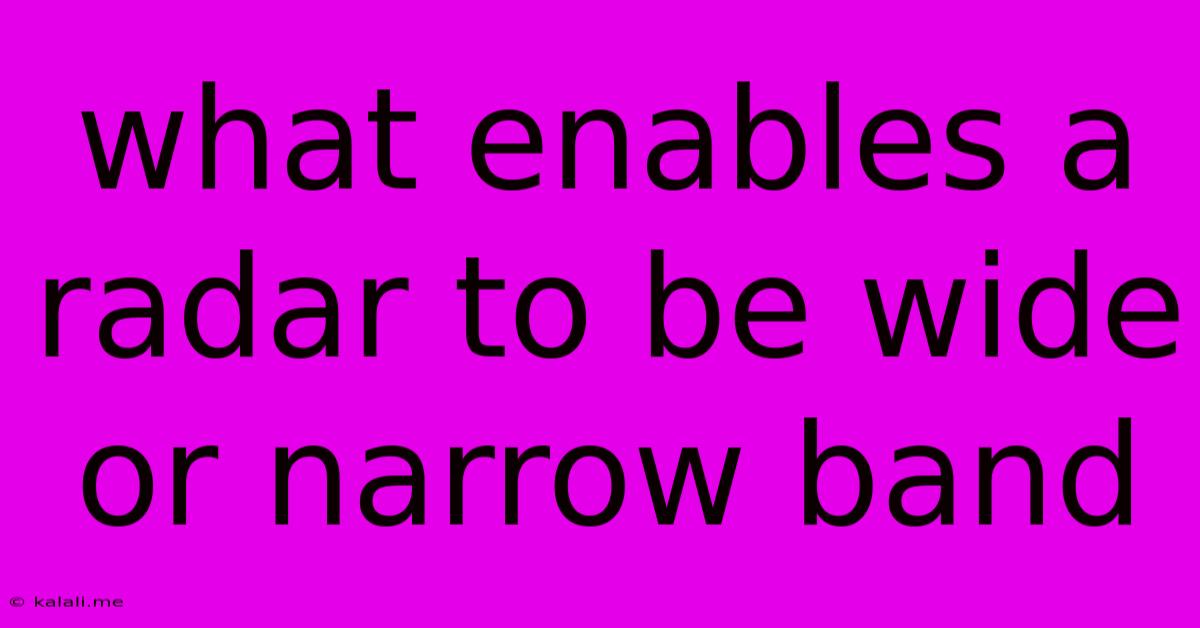What Enables A Radar To Be Wide Or Narrow Band
Kalali
May 30, 2025 · 3 min read

Table of Contents
What Enables a Radar to be Wideband or Narrowband?
Meta Description: Understanding radar bandwidth is crucial for application selection. This article explores the factors determining whether a radar system is wideband or narrowband, focusing on pulse compression, signal processing, and application needs.
Radar systems, crucial for various applications from weather forecasting to aircraft detection, are categorized as either wideband or narrowband depending on their operating bandwidth. This bandwidth significantly impacts the radar's performance characteristics, influencing its range resolution, ability to penetrate clutter, and overall effectiveness. But what precisely determines whether a radar operates within a wide or narrow bandwidth? The answer lies in a combination of factors, primarily revolving around the transmitted signal characteristics and the signal processing techniques employed.
Understanding Bandwidth: The Basics
Bandwidth, in the context of radar, refers to the range of frequencies occupied by the transmitted signal. A narrowband radar utilizes a small range of frequencies, typically a single frequency or a very narrow band around a center frequency. Conversely, a wideband radar employs a significantly broader range of frequencies. This seemingly simple distinction has profound consequences for the radar's capabilities.
Factors Determining Radar Bandwidth
Several key factors contribute to a radar system's bandwidth:
-
Pulse Compression: This powerful technique allows narrowband radars to achieve high range resolution. A long, low-power pulse is modulated with a specific code (e.g., linear frequency modulation or phase coding). Upon reception, this code is matched with the received signal using a correlator. The result is a compressed pulse, effectively achieving the range resolution of a much shorter, higher-power pulse without sacrificing transmit power or increasing peak power limitations. While employing pulse compression, the instantaneous bandwidth remains narrow, but the overall processed bandwidth is effectively widened.
-
Signal Processing Techniques: The methods used to process the received signals directly influence the bandwidth. Digital signal processing (DSP) techniques are crucial for wideband radars, allowing for efficient handling of large amounts of data and complex signal processing algorithms. These techniques are essential for tasks like matched filtering (used in pulse compression) and advanced clutter rejection.
-
Transmitter Design: The design of the radar transmitter itself plays a vital role. Wideband systems require transmitters capable of generating and amplifying a wider range of frequencies with consistent power and phase characteristics across the bandwidth. This necessitates sophisticated components and circuitry, contributing to the increased cost and complexity of wideband radars.
-
Antenna Design: The antenna's design and characteristics also impact the achievable bandwidth. Wideband antennas must maintain efficient radiation across a broader frequency range, which is a challenging design consideration.
-
Application Requirements: The specific application often dictates the necessary bandwidth. High-resolution imaging radars, for instance, often require wideband operation to achieve fine details. On the other hand, applications that prioritize long-range detection might prioritize narrowband operation for increased transmit power. Weather radars, for example, often operate with narrower bandwidths to maximize range.
Wideband vs. Narrowband: A Comparison
| Feature | Wideband Radar | Narrowband Radar |
|---|---|---|
| Bandwidth | Broad range of frequencies | Narrow range of frequencies |
| Range Resolution | High | Low (unless pulse compression is used) |
| Clutter Rejection | Potentially better, due to increased information | Can be challenging |
| Complexity | Higher | Lower |
| Cost | Generally higher | Generally lower |
| Applications | High-resolution imaging, through-wall imaging | Long-range detection, weather monitoring |
Conclusion
Whether a radar is wideband or narrowband is not simply a matter of choice, but rather a result of a complex interplay between technological capabilities, signal processing techniques, and application requirements. The selection of the appropriate bandwidth profoundly impacts the radar's performance and suitability for its intended purpose. The future of radar technology likely involves increasingly sophisticated wideband systems capable of extracting even more information from the reflected signals, pushing the boundaries of what's possible in sensing and imaging.
Latest Posts
Latest Posts
-
Do Led Lights Emit Uv Rays
May 31, 2025
-
What Does Restore From This Backup Mean
May 31, 2025
-
What Is The Bond Order Of S2
May 31, 2025
-
Was Mary From The House Of David
May 31, 2025
-
What Does 2nf Mean On Multimeter
May 31, 2025
Related Post
Thank you for visiting our website which covers about What Enables A Radar To Be Wide Or Narrow Band . We hope the information provided has been useful to you. Feel free to contact us if you have any questions or need further assistance. See you next time and don't miss to bookmark.